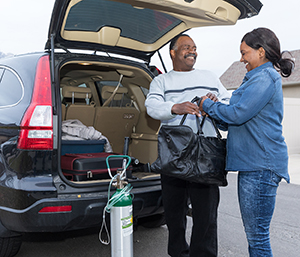Chronic lung disease shouldn’t stop you from traveling, visiting family and friends, and enjoying yourself. You can do this even if you use oxygen. You just need to be prepared. Changes in altitude and climate can affect breathing. This may mean making changes to your treatment. So talk with your healthcare provider about your plans.
Before traveling
Get ready before taking a trip:
-
Get your prescriptions filled. Bring enough medicine for your whole trip.
-
Get copies of your prescriptions. Ask your healthcare provider if you might need prescriptions for any other medicines while traveling.
-
Bring a list of your medicines.
-
Ask your provider what to do in case of infection or a flare-up of COPD symptoms. They may prescribe emergency medicines just in case. These may include antibiotics or steroids.
-
Call your insurance company. Make sure you’ll have coverage where you’re going.
-
Get a portable nebulizer (if needed).
-
If traveling with oxygen, plan ahead:
-
Call your provider to get copies of your oxygen prescription.
-
You may need a letter from your provider stating that you must use oxygen.
-
You may need to have oxygen sent to your destination. Before you travel, call a medical supply company where you'll be staying. They can help make sure oxygen gets there before you do.
-
Call the airline, bus, boat, or train company you'll be using. Find out what's required for traveling with oxygen.
-
Give yourself a few weeks to make these arrangements.
-
While traveling
Tips to make traveling easier:
-
Wear a medical ID bracelet. This should list your health conditions. And any medicines you’re allergic to.
-
Use a hand sanitizer often. This helps kill germs and prevent infection.
-
Keep your medicines in your carry-on bags. This way, you’ll have them if you get separated from your checked luggage.
-
Use your metered dose or rescue inhaler before you get up to move around if one has been prescribed. For example, you may use it before getting off the plane. It's very important to always use the correct technique when using your inhaler.
-
Stretch your arms and legs if you’re sitting for a long time. This helps keep your blood moving. Try using your ankles and feet to spell out each letter of the alphabet.


